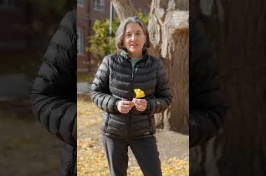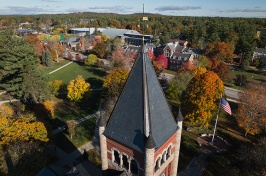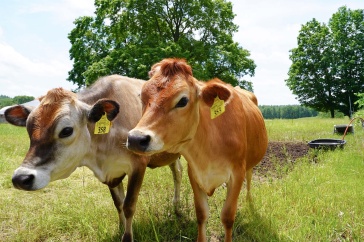A forage for each 'slump'
NHAES scientists have identified some of the best performing and most nutritious forage crops for three periods of the year when forage growth slows or stops in the Northeast. They identified these crops in three research papers published in Crop Forage & Turfgrass Management journal.
For the Early Spring slump: Winter annual forage mass-nutritive value trade-offs are affected by harvest timing
Top performing early spring forages:
For the Mid-to-Late Summer slump: Evaluating warm-season annual forages to fill summer forage gaps in short-season climates
Top performing mid-to-late summer forage:
For the Early Fall slump: Identifying optimal early-season harvest timing in annual fall forages
Top performing early fall forage:
Do you remember coming back to school after a summer break and taking a while to recall the details of what you had learned the previous academic year? A similar ‘summer slump’ exists in farming, during periods of the growing season when traditional forage plants—eaten by livestock—don’t grow well or aren’t readily available. Scientists with the New Hampshire Agricultural Experiment Station (NHAES) are helping identify what forage crops could be grown to supplement traditional forages during these seasonal ‘slumps.’
These forage ‘slumps’ can impact dairy and livestock production–and threaten livelihoods–by making it more difficult and expensive to feed grazing animals. In New Hampshire, there’s more than 64,000 acres of forage land used by cattle, goats, pigs horses and other livestock, according to the USDA’s most recent statewide Census of Agriculture. The International Dairy Foods Association reports that the Granite State’s dairy industry directly supports more than 5,100 jobs and accounts for 2.3 percent of New Hampshire’s gross domestic product (GDP). Across northern New England, farmers often choose cool-season perennials, such as alfalfa, orchard grass and red and white clover, for their forage crops. However, with these traditional forages, growth stops or slows during three seasonal ‘slumps’: early spring; the middle of summer, when excessive heat slows or stops most plant growth; and during the late fall, prior to the arrival of killing.
“Our project was really trying to target these three periods when traditional forages are not productive and see if we could identify cool and warm season annual crops that could help supplement these periods,” described NHAES scientist Rich Smith, an associate professor in the Natural Resources and the Environment department at UNH. “We evaluated each supplemental forage crop based on its biomass (total production or dry matter) and nutritional value for livestock.”
“We not only examined how these species performed in terms of production and nutritive value, but we also identified other qualities in each species, like how weed suppressive they were and how well they grew when planted together in a mixture” he added. “And it was really interesting seeing how different (or similar) these species were when compared head-to-head.”
“We not only examined how these species performed in terms of production and nutritive value, but we also identified other qualities in each species, like how weed suppressive they were and how well they grew when planted together in a mixture. And it was really interesting seeing how different (or similar) these species were when compared head-to-head.”
Smith and his colleagues, including NHAES scientist Andre Brito, an associate professor in the Agriculture, Nutrition, and Food Systems department, and research scientist Nick Warren, manager of the UNH Agroecology Lab, published their findings in three separate articles in Crop Forage & Turfgrass Management journal.
“There’s a lot of interest from farmers in grazing their cover crops, as a way to get some extra added value out of those crops,” said Smith. “This study really nicely evaluated using cover crops for grazing and some of the best seasonal times that they could be used.”
Their study took place over three growing seasons (2015-17) at UNH’s Kingman Research Farm. For each ‘slump’ period, the researchers grew and evaluated 5-6 different species. Each species was selected for its suitability to the northern New England climate; whether it was a warm- or cool-season crop; and if it was a legume, grass, or of another plant family, said Smith. Each trial included at least one legume, several species of grasses, and in most cases a non-legume broad-leaf species). Additionally, the researchers harvested the plants at different growth stages to determine the optimal timing that balanced both productivity and nutritive value.
The researchers found that barley (Hordeum vulgare L.) and triticale (Secale x Triticum) performed best (in terms of the amount that grew and the nutritional value of the plant) in the early spring, Japanese millet (Echniochloa esculenta) mid-summer, and canola (Brassica napus L.) for late fall.
The researchers found that barley (Hordeum vulgare L.) and triticale (Secale x Triticum) performed best (in terms of the amount that grew and the nutritional value of the plant) in the early spring, Japanese millet (Echniochloa esculenta) mid-summer, and canola (Brassica napus L.) for late fall.

“There’s probably not one single species that would work across all three slump periods, so we looked at a diversity of plants that might do well during each,” Smith added. “On top of that, we wanted to find those species that had the highest amount of plant material (biomass) and offered the highest nutritional value to dairy cows – and when those harvest times were when both biomass and nutritional value were together at their peaks.”
Following each of the three cuttings, Brito analyzed each species for various forage qualities, including digestibility and protein content.
“I was really pleased that we could find the ‘sweet spot,’ where quantity and quality was highest, and we were able to report those data,” said Brito. “That’s really important and practical information for farmers – sharing that information on when you can get the most out of your forage crop.”
For Smith, the research also offered an opportunity to highlight the versatility of these crops, not just as forages, but also as cover crops.
“There’s a lot of interest among farmers in grazing their cover crops, as way to get some added value or as a strategy for terminating them,” said Smith. “This study should give farmers a better idea about which cover crops might be better suited for grazing at different times of the year.”
Additionally, the researchers believe their work will become even more useful in the future as the region’s climate continues to change.
“In the past, we wouldn’t always have a summer slump, but we’re seeing droughts like this year’s become more and more common,” Smith said. “So, identifying alternative forages that might better perform better during hot and dry periods, which seem to be becoming more and more frequent, is going to be that much more important for farmers.”
This material is based on work supported by the NH Agricultural Experiment Station through joint funding from the USDA National Institute of Food and Agriculture (under Hatch award numbers 7000871 and 1017808) and the state of New Hampshire.
You can read the three articles in the Crop Forage & Turfgrass Management journal. Winter annual forage mass-nutritive value trade-offs are affected by harvest timing was published in Vol. 7, Issue 2. Evaluating warm-season annual forages to fill summer forage gaps in short-season climates was published in Vol. 8, Issue 1. Identifying optimal early-season harvest timing in annual fall forages was published in Vol. 8, Issue 2.
-
Written By:
Nicholas Gosling '06 | COLSA/NH Agricultural Experiment Station | nicholas.gosling@unh.edu

















































